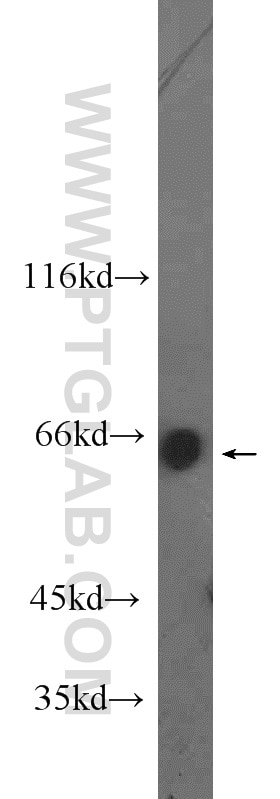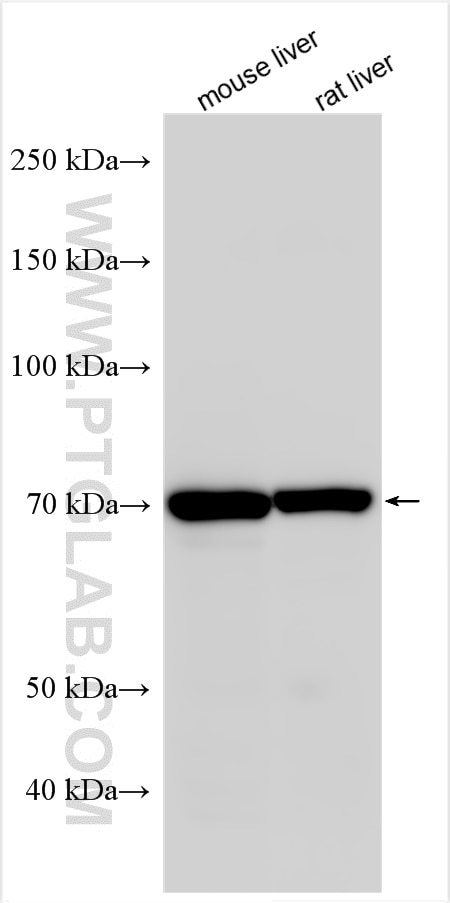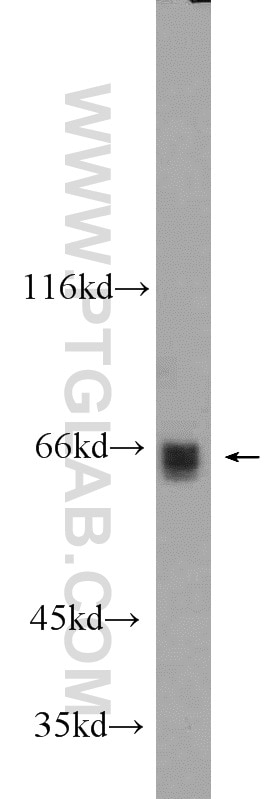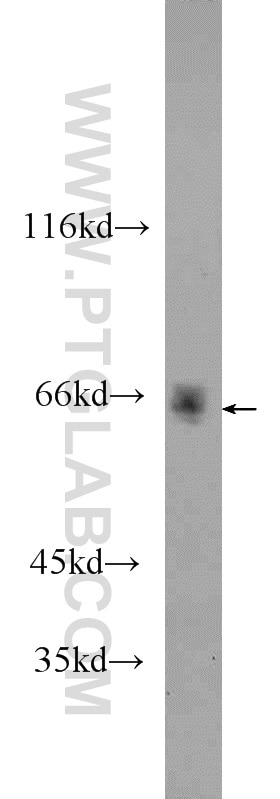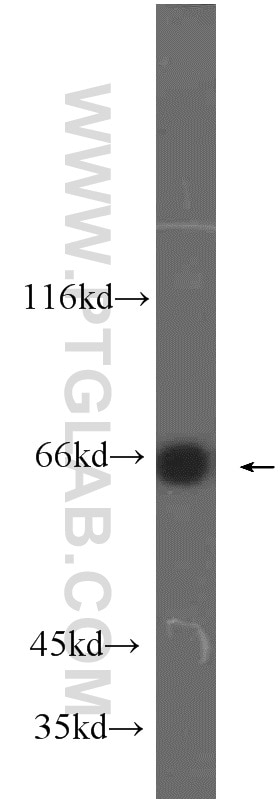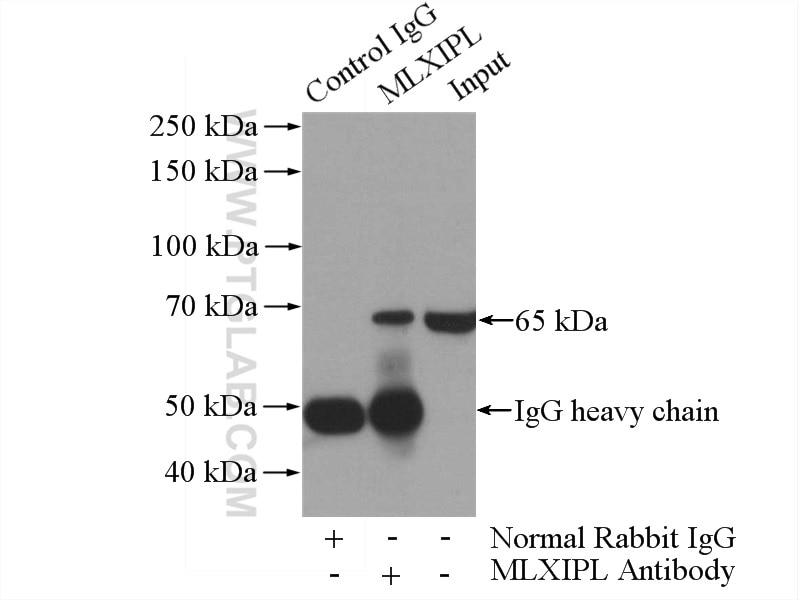MLXIPL Polyklonaler Antikörper
MLXIPL Polyklonal Antikörper für WB, IP, ELISA
Wirt / Isotyp
Kaninchen / IgG
Getestete Reaktivität
human, Maus, Ratte
Anwendung
WB, IHC, IF, IP, ELISA
Konjugation
Unkonjugiert
Kat-Nr. : 13256-1-AP
Synonyme
Geprüfte Anwendungen
| Erfolgreiche Detektion in WB | Mauslebergewebe, HeLa-Zellen, HepG2-Zellen, humanes Lebergewebe, Rattenlebergewebe |
| Erfolgreiche IP | HepG2-Zellen |
Empfohlene Verdünnung
| Anwendung | Verdünnung |
|---|---|
| Western Blot (WB) | WB : 1:500-1:1000 |
| Immunpräzipitation (IP) | IP : 0.5-4.0 ug for 1.0-3.0 mg of total protein lysate |
| It is recommended that this reagent should be titrated in each testing system to obtain optimal results. | |
| Sample-dependent, check data in validation data gallery | |
Veröffentlichte Anwendungen
| WB | See 16 publications below |
| IHC | See 1 publications below |
| IF | See 4 publications below |
Produktinformation
13256-1-AP bindet in WB, IHC, IF, IP, ELISA MLXIPL und zeigt Reaktivität mit human, Maus, Ratten
| Getestete Reaktivität | human, Maus, Ratte |
| In Publikationen genannte Reaktivität | human, Maus |
| Wirt / Isotyp | Kaninchen / IgG |
| Klonalität | Polyklonal |
| Typ | Antikörper |
| Immunogen | MLXIPL fusion protein Ag3481 |
| Vollständiger Name | MLX interacting protein-like |
| Berechnetes Molekulargewicht | 852 aa, 93 kDa |
| Beobachtetes Molekulargewicht | 65 kDa |
| GenBank-Zugangsnummer | BC012925 |
| Gene symbol | MLXIPL |
| Gene ID (NCBI) | 51085 |
| Konjugation | Unkonjugiert |
| Form | Liquid |
| Reinigungsmethode | Antigen-Affinitätsreinigung |
| Lagerungspuffer | PBS with 0.02% sodium azide and 50% glycerol |
| Lagerungsbedingungen | Bei -20°C lagern. Nach dem Versand ein Jahr lang stabil Aliquotieren ist bei -20oC Lagerung nicht notwendig. 20ul Größen enthalten 0,1% BSA. |
Hintergrundinformationen
Carbohydrate response element-binding protein (ChREBP), also known as MLXIPL, is a glucose-responsive transcription factor that has a fundamental role in the glucose-mediated induction of genes involved in hepatic glycolysis and lipogenesis. Circulating blood glucose levels affect ChREBP activity in hepatocytes largely by post-translational mechanisms that include phosphorylation-dependent subcellular localization [PMID:21665952]. It enhances expression of the liver pyruvate kinase (LPK) gene and all lipogenic enzyme genes resulting in the conversion of excess dietary carbohydrate into triglycerides that can be stored as fat [PMID:15118080]. Molecular Weight of ChREBP splice variants: 62/78/91/93 kDa.
Protokolle
| PRODUKTSPEZIFISCHE PROTOKOLLE | |
|---|---|
| WB protocol for MLXIPL antibody 13256-1-AP | Protokoll herunterladen |
| IP protocol for MLXIPL antibody 13256-1-AP | Protokoll herunterladen |
| STANDARD-PROTOKOLLE | |
|---|---|
| Klicken Sie hier, um unsere Standardprotokolle anzuzeigen |
Publikationen
| Species | Application | Title |
|---|---|---|
EMBO Rep Lin28 enhances de novo fatty acid synthesis to promote cancer progression via SREBP-1. | ||
Clin Transl Med Phosphoproteome reveals molecular mechanisms of aberrant rhythm in neurotransmitter-mediated islet hormone secretion in diabetic mice. | ||
Front Pharmacol Roxadustat, a Hypoxia-Inducible Factor 1α Activator, Attenuates Both Long- and Short-Term Alcohol-Induced Alcoholic Liver Disease. | ||
J Agric Food Chem Diosmetin Ameliorates Nonalcoholic Steatohepatitis through Modulating Lipogenesis and Inflammatory Response in a STAT1/CXCL10-Dependent Manner. | ||
J Agric Food Chem Baicalein Enhances the Effect of Acarbose on the Improvement of Nonalcoholic Fatty Liver Disease Associated with Prediabetes via the Inhibition of De Novo Lipogenesis. | ||
Food Funct Polysaccharide MCP extracted from Morchella esculenta reduces atherosclerosis in LDLR-deficient mice. |
